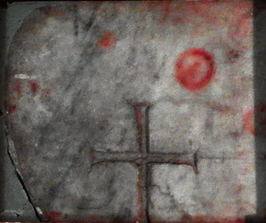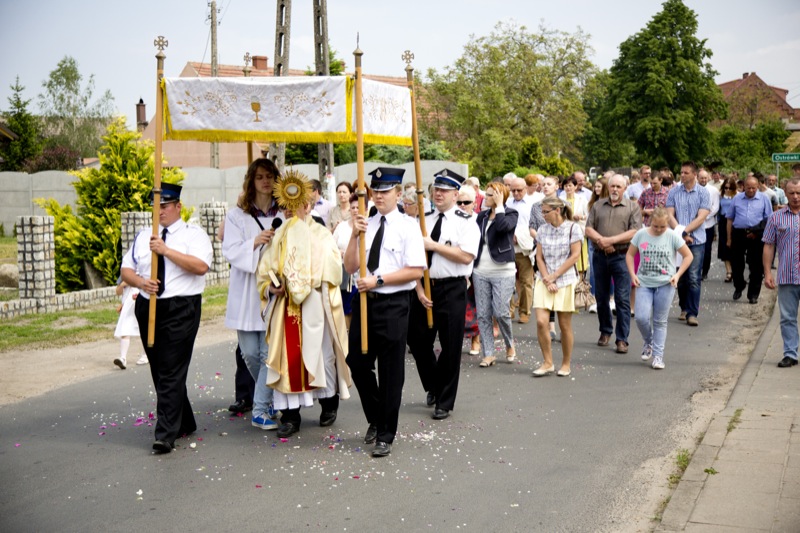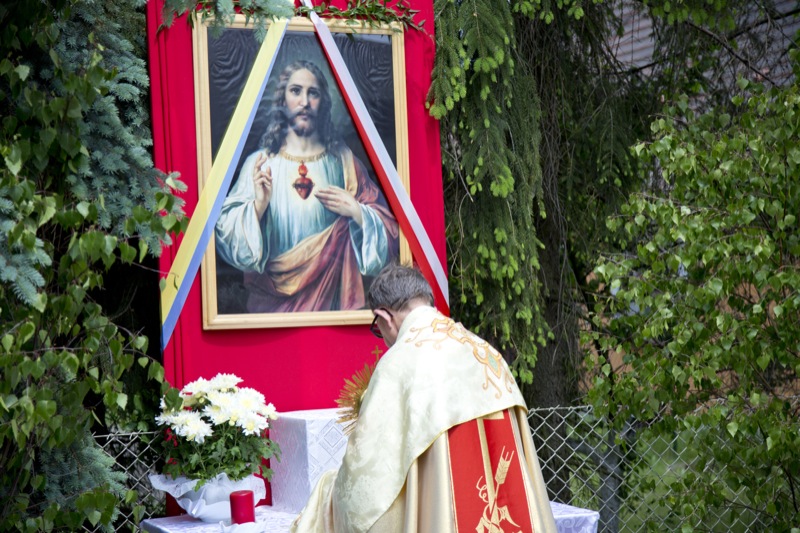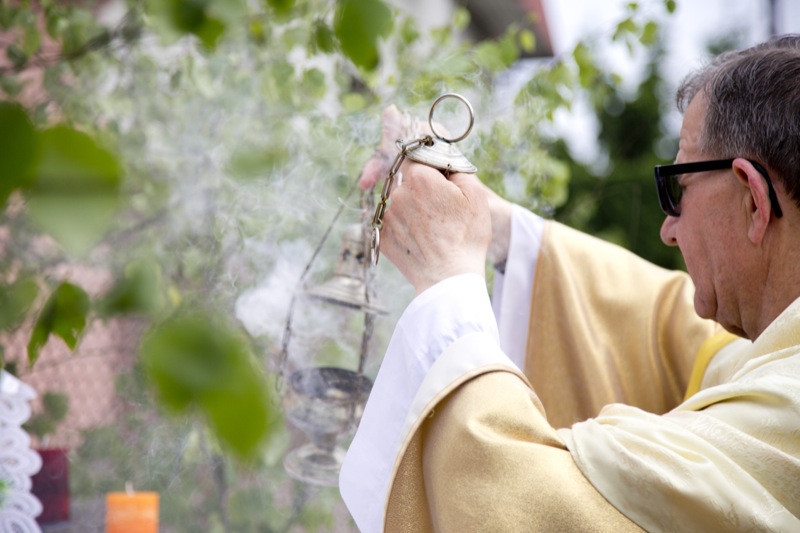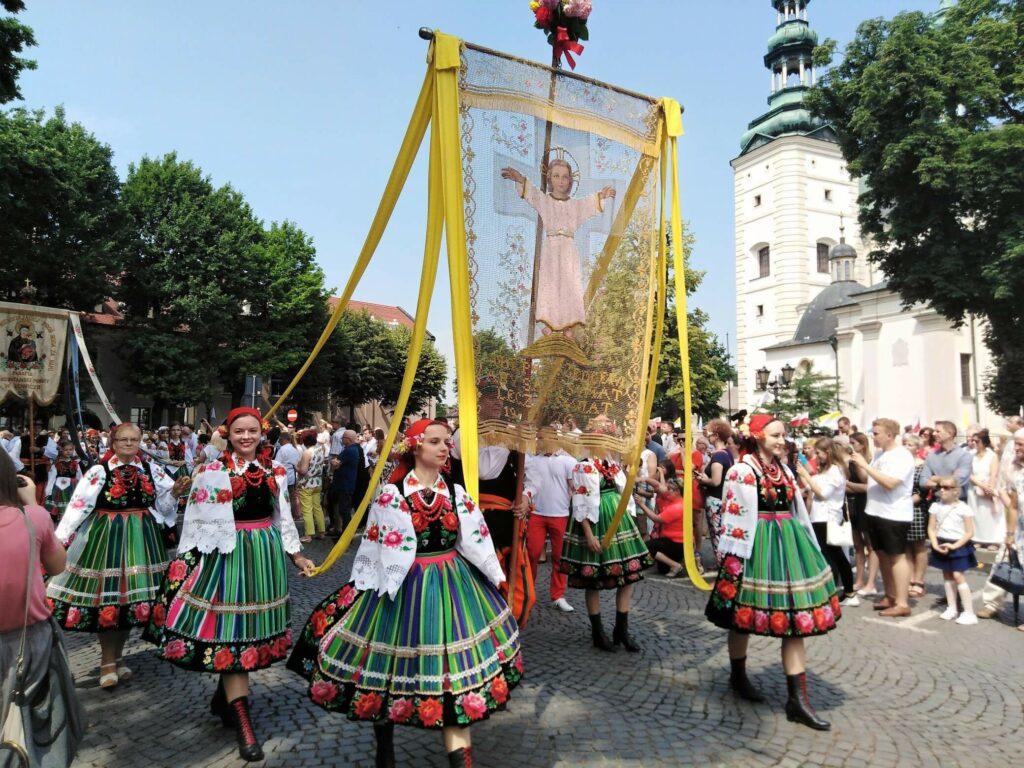| Solemnity of The Most Holy Body and Blood of Christ | |
|---|---|

Corpus Christi procession. Oil on canvas by Carl Emil Doepler. |
|
| Official name | Solemnity of the Most Holy Body and Blood of Christ |
| Also called | Corpus Domini |
| Observed by | as a public holiday in Austria, Brazil, Bolivia, Bosnia and Herzegovina, Colombia, Croatia, Dominican Republic, Haiti, East Timor, Equatorial Guinea, parts of Germany, Grenada, Liechtenstein, Mexico, Monaco, Panama, Peru, Poland, Portugal, Philippines, Saint Lucia, San Marino, parts of Spain, parts of Switzerland, Trinidad and Tobago |
| Date | Thursday after Trinity Sunday; 60 days after Easter, or the Sunday immediately following this |
| 2022 date | June 16 |
| 2023 date | June 8[1] |
| 2024 date | May 30 |
| 2025 date | June 19 |
| Frequency | annual |
Rock of the Eucharistic Miracle in Bolsena (1253)
The Feast of Corpus Christi (Ecclesiastical Latin: Dies Sanctissimi Corporis et Sanguinis Domini Iesu Christi, lit. ‘Day of the Most Holy Body and Blood of Jesus Christ the Lord’), also known as the Solemnity of the Most Holy Body and Blood of Christ,[2] is a Christian liturgical solemnity celebrating the Real Presence of the Body and Blood, Soul and Divinity of Jesus Christ in the elements of the Eucharist; it is observed by the Roman Catholic Church, in addition to certain Western Orthodox, Lutheran, and Anglican churches. Two months earlier, the institution of the Eucharist at the Last Supper is observed on Maundy Thursday in a sombre atmosphere leading to Good Friday. The liturgy on that day also commemorates Christ’s washing of the disciples’ feet, the institution of the priesthood, and the agony in the Garden of Gethsemane.
The feast of Corpus Christi was proposed by Saint Thomas Aquinas, Doctor of the Church, to Pope Urban IV, in order to create a feast focused solely on the Holy Eucharist, emphasizing the joy of the Eucharist being the Body and Blood, Soul and Divinity of Jesus Christ. Having recognized in 1264 the authenticity of the Eucharistic Miracle of Bolsena, on input of Aquinas,[citation needed] the pontiff, then living in Orvieto, established the feast of Corpus Christi as a Solemnity and extended it to the whole Roman Catholic Church.[3][4]
The feast is liturgically celebrated on the Thursday after Trinity Sunday or, «where the Solemnity of The Most Holy Body and Blood of Christ is not a holy day of obligation, it is assigned to the Sunday after the Most Holy Trinity as its proper day».[5]
At the end of Holy Mass, there is often a procession of the Blessed Sacrament, generally displayed in a monstrance. The procession is followed by the Benediction of the Blessed Sacrament.[6] A notable Eucharistic procession is that presided over by the Pope each year in Rome, where it begins at the Archbasilica of St. John Lateran and passes to the Basilica of Saint Mary Major, where it concludes with the aforementioned Benediction. Corpus Christi wreaths, which are made of flowers, are hung on the doors and windows of the Christian faithful, in addition to being erected in gardens and fields.[6]
The celebration of the feast was suppressed in Protestant churches during the Reformation for theological reasons: outside Lutheranism, which maintained the confession of the Real Presence, many Protestants denied the real presence of Christ in the Eucharist other than as a merely symbolic or spiritual presence. Today, most Protestant denominations do not recognize the feast day,[7] with exception of certain Lutheran churches and the Church of England, the latter of which abolished it in 1548 as the English Reformation progressed, but later reintroduced it.[8] Some Anglican churches now observe Corpus Christi, sometimes under the name «Thanksgiving for Holy Communion».
History[edit]
Juliana of Liège[edit]
The institution of Corpus Christi as a feast in the Christian calendar resulted from approximately forty years of work on the part of Juliana of Liège, a 13th-century Norbertine canoness, also known as Juliana de Cornillon, born in 1191 or 1192 in Liège, Belgium, a city where there were groups of women dedicated to Eucharistic worship. Guided by exemplary priests, they lived together, devoted to prayer and to charitable works. Orphaned at the age of five, she and her sister Agnes were entrusted to the care of the Augustinian nuns at the convent and leprosarium of Mont-Cornillon, where Juliana developed a special veneration for the Blessed Sacrament.[9]
She always longed for a feast day outside of Lent in its honour. Her vita reports that this desire was enhanced by a vision of the church under the appearance of the full moon having one dark spot, which signified the absence of such a solemnity.[10][11] In 1208, she reported her first vision of Christ in which she was instructed to plead for the institution of the feast of Corpus Christi. The vision was repeated for the next 20 years but she kept it a secret. When she eventually relayed it to her confessor, he relayed it to the bishop.[12]
Juliana also petitioned the learned Dominican Hugh of St-Cher, and Robert de Thorete, Bishop of Liège. At that time bishops could order feasts in their dioceses, so Bishop Robert ordered in 1246 a celebration of Corpus Christi to be held in the diocese each year thereafter on the Thursday after Trinity Sunday.[13][14][15] The first such celebration occurred at St Martin’s Church in the city that same year.
Hugh of St-Cher travelled to Liège as Cardinal-Legate in 1251 and, finding that the feast was not being observed, reinstated it. In the following year, he established the feast for his whole jurisdiction (Germany, Dacia, Bohemia, and Moravia), to be celebrated on the Thursday after the Octave of Trinity (one week later than had been indicated for Liège), but with a certain elasticity, for he granted an indulgence for all who confessed their sins and attended church «on a date and in a place where [the feast] was celebrated».[16]
Jacques Pantaléon of Troyes was also won over to the cause of the Feast of Corpus Christi during his ministry as Archdeacon in Liège under the diocesan bishop Robert of Thourotte. It was he who, having become Pope as Urban IV in 1264, instituted the Solemnity of Corpus Christi on the Thursday after Pentecost as a feast for the entire Latin Church, by the papal bull Transiturus de hoc mundo.[9][16] The legend that this act was inspired by a procession to Orvieto in 1263, after a village priest in Bolsena and his congregation witnessed a Eucharistic miracle of a bleeding consecrated host at Bolsena,[15] has been called into question by scholars who note problems in the dating of the alleged miracle, whose tradition begins in the 14th century, and the interests of Urban IV, a former Archdeacon in Liège. Though this was the first papally imposed universal feast for the Latin Church,[17] it was not in fact widely celebrated for half a century, although it was adopted by a number of dioceses in Germany and by the Cistercians, and in 1295 was celebrated in Venice.[18] It became a truly universal feast only after the bull of Urban IV was included in the collection of laws known as the Clementines, compiled under Pope Clement V, but promulgated only by his successor Pope John XXII in 1317.[18][19]
While the institution of the Eucharist is celebrated on Holy (Maundy) Thursday, the liturgy on that day also commemorates Christ’s washing of the disciples’ feet, the institution of the priesthood and the agony in the Garden of Gethsemane. So many other functions took place on this day that the principal event was almost lost sight of. This is mentioned in the Bull Transiturus as the chief reason for the introduction of the new feast. Hence, the feast of Corpus Christi was established to create a feast focused solely on the Holy Eucharist.[10]
Three versions of the office for the feast of Corpus Christi in extant manuscripts provide evidence for the Liège origins and voice of Juliana in an original office, which was followed by two later versions of the office. A highly sophisticated and polished version can be found in BNF 1143, a musical manuscript devoted entirely to the feast, upon which there is wide scholarly agreement: the version in BNF 1143 is a revision of an earlier version found in Prague, Abbey of Strahov MS D.E.I. 7, and represents the work of Thomas Aquinas following or during his residency at Orvieto from 1259 to 1265. The office can also be found in the 1343 codex Regimen Animarum.[20]: 13 This liturgy may be used as a votive Mass of the Blessed Sacrament on weekdays in ordinary time.[21] The hymn Aquinas composed for Vespers of Corpus Christi, Pange Lingua or another eucharistic hymn, is also used on Maundy Thursday during the procession of the Blessed Sacrament to the altar of repose.[22] The last two verses of Pange Lingua are also used as a separate hymn, Tantum Ergo, which is sung at Benediction of the Blessed Sacrament. O Salutaris Hostia, another hymn sung at Benediction of the Blessed Sacrament, comprises the last two verses of Verbum Supernum Prodiens, Aquinas’ hymn for Lauds of Corpus Christi. Aquinas also composed the propers for the Mass of Corpus Christi, including the sequence Lauda Sion Salvatorem. The epistle reading for the Mass was taken from Paul’s First Epistle to the Corinthians (1 Corinthians 11:23–29), and the Gospel reading was taken from the Gospel of John (John 6:56–59).
When Pope Pius V revised the General Roman Calendar (see Tridentine Calendar), Corpus Christi was one of only two «feasts of devotion» that he kept, the other being Trinity Sunday.[23] In that calendar, Corpus Christi was celebrated on the Thursday after Trinity Sunday.[24] The feast had an octave until 1955, when Pope Pius XII suppressed all octaves, even in local calendars, except those of Christmas, Easter and Pentecost (see General Roman Calendar of Pope Pius XII).
From 1849 until 1969, a separate Feast of the Most Precious Blood of Our Lord Jesus Christ was assigned originally to the first Sunday in July, later to the first day of the month. This feast was removed from the General Roman Calendar in 1969, «because the Most Precious Blood of Christ the Redeemer is already venerated in the solemnities of the Passion, of Corpus Christi and of the Sacred Heart of Jesus and in the feast of the Exaltation of the Holy Cross. But the Mass of the Most Precious Blood of Our Lord Jesus Christ is placed among the votive Masses».[25]
Celebration[edit]
Roman Catholic Church[edit]
The feast of Corpus Christi is one of five occasions in the year on which a diocesan bishop is not to be away from his diocese unless for a grave and urgent reason.[26]
In many countries, the day is a holy day of obligation to participate in the celebration of Mass and takes place on the Thursday after Trinity Sunday. On that day or on the following Sunday, which is the feast day where it is not a holy day of obligation, it is traditional to hold in the streets of a town or in an individual parish a procession with prayers and singing to honor the Blessed Sacrament. German processional hymns include the 1687 «Kommt her, ihr Kreaturen all». During the procession, the consecrated host is displayed in a monstrance held aloft by a member of the clergy. At the end of the procession, Benediction of the Blessed Sacrament is imparted.[27]
Anglicanism[edit]
The celebration of Corpus Christi was abolished in England in 1548.[28][29] However, in the Church of England «the Thursday after Trinity Sunday may be observed as The Day of Thanksgiving for the Institution of Holy Communion (Corpus Christi)» as one of the church’s Festivals and with a special liturgy.[30]
The feast is also celebrated by Anglo-Catholic parishes, even in provinces of the Anglican Communion that do not officially include it in their calendars. McCausland’s Order of Divine Service, the most commonly used ordo in the Anglican Church of Canada, provides lections for the day.[citation needed]
Other churches[edit]
Corpus Christi is also celebrated by the Old Catholic Church, the Liberal Catholic Church and by some Western Rite Orthodox Christians. It is commemorated in the liturgical calendars of the more Latinized Eastern Catholic Churches.[citation needed]
Lutheranism[edit]
Martin Luther spoke out against processing with the consecrated elements, which he viewed as «only play-acting» and «just vain idolatry». In one of his postils (homilies), he wrote
I am to no festival more hostile … than this one. Because it is the most shameful festival. At no festival are God and his Christ more blasphemed, than on this day, and particularly by the procession. For then people are treating the Blessed Sacrament with such ignominy that it becomes only play-acting and is just vain idolatry. With its cosmetics and false holiness it conflicts with Christ’s order and establishment. Because He never commanded us to carry on like this. Therefore, beware of such worship![31]
However, the feast was retained in the calendars of the Lutheran Church until about 1600.[32]
Calvinism[edit]
Like Lutherans, followers of the Reformed tradition do not observe the feast.[33]
Folk traditions[edit]
On the eve of the Feast of Corpus Christi, clergy bless Corpus Christi wreaths that are made of flowers.[6] Corpus Christi wreaths and bouquets are often «attached to flags and banners, to houses, and to the arches of green boughs that span the streets.»[6] In Christian homes, these Corpus Christi wreaths are suspended on walls or displayed on doors and in windows.[6] Corpus Christi wreaths are also «put up in gardens, fields, and pastures, with a prayer for protection and blessing upon the growing harvest.»[6]
Throughout Christendom, «the custom developed of carrying the Blessed Sacrament in a splendid procession through the town after the Mass on Corpus Christi Day.»[6] The monstrance which holds the host is surrounded by a Corpus Christi wreath of flowers.[6] During the procession, church bells are rung and «the faithful kneel in front of their homes to adore the Eucharistic Lord.»[6] Along the route in which the procession occurs, Christian homes «are decorated with little birch trees and green boughs», with candles being lit in the windows.[6] Oftentimes, stops are made at various points called «stations» during the procession and «the Blessed Sacrament is put on an altar table» while a Gospel passage is read and hymns are sung, along with prayer being made.[6]
England[edit]
In medieval times in many parts of Europe, Corpus Christi was a time for the performance of mystery plays. The plays in York, England, were performed on Corpus Christi Day for some 200 years until their suppression in the sixteenth century during the Protestant Reformation.[34]
Peru[edit]
In the southern highlands of the Cusco Region of Peru, the festival of Quyllurit’i is held near Corpus Christi in the Sinaqara Valley. As many as 10,000 pilgrims come from neighboring areas. Culminating on Trinity Sunday, this festival marks the return in the sky of the Pleiades constellation, known in the Quechua language as Qullqa, or «storehouse», as it is associated with the upcoming harvest and New Year. The festival precedes the official feast of Corpus Christi, held the Thursday following Trinity Sunday, but it is closely associated with it.[35]
Poland[edit]
In Spycimierz in central Poland (Gmina Uniejów), parishioners arrange a carpet of live flowers about one kilometre long. A solemn procession passes over it at 5 pm. [36] Long carpets of flowers are also laid in four parishes in the Opole Voivodship in southern Poland. Flower carpets tradition for Corpus Christi processions was inscribed on the UNESCO Representative List of the Intangible Cultural Heritage of Humanity in 2021. [37]
Spain[edit]
Andalucia[edit]
The celebrations in Seville are depicted in a section of Iberia, the masterpiece of the composer Albéniz.
Castile-La Mancha[edit]
Corpus Christi is one of the main festivals in Toledo, Spain.[citation needed]
Castile and León[edit]
In the village of Castrillo de Murcia near Burgos, the celebration includes the practice of El Colacho (baby jumping).[38]
Catalonia[edit]
In Catalonia, Corpus Christi is celebrated with the tradition of the dancing egg. There is evidence this tradition dates from the 16th century.[39]
The Patum de Berga is a popular and traditional festival that is celebrated each year in the Catalan city of Berga (Barcelona) during Corpus Christi. It consists of a series of «dances» (balls) by townspeople dressed as mystical and symbolical figures. The balls are marked by their solemnity and their ample use of fire and pyrotechnics. It was declared a Traditional Festival of National Interest by the Generalitat de Catalunya in 1983, and as a Masterpiece of the Oral and Intangible Heritage of Humanity by UNESCO in 2005.[40]
Date[edit]
Corpus Christi is a moveable feast, celebrated on the Thursday after Trinity Sunday,[10] 60 days after Easter, or, in countries where it is not a holy day of obligation, on the following Sunday.[41]
The earliest possible Thursday celebration falls on 21 May (as in 1818 and 2285), the latest on 24 June (as in 1943 and 2038). The Sunday celebration of the feast, introduced in the second half of the 20th century, occurs three days later, between 24 May at earliest (for the first time in 2285) and 27 June at latest (for the first time in 2038). For Western Rite Orthodox Christians, since they use the Julian Calendar, at least for all Feast Days dependent on the date of Pascha, their date of the celebration of Corpus Christi, translates to, in the Gregorian Calendar, from 3 June at the earliest, to 7 July, at the latest.
Corpus Christi is a public holiday in some countries with a predominantly Catholic population including, among others, Argentina, Austria, Bolivia, parts of Bosnia and Herzegovina, Brazil, Colombia, Croatia, Dominican Republic, East Timor, Equatorial Guinea, parts of Germany, Grenada, Haiti, Jerusalem in Israel, Liechtenstein, Monaco, Paraguay, Peru, Poland, Portugal, parts of Puerto Rico, Saint Lucia, San Marino, Spain, parts of Switzerland, Trinidad and Tobago, parts of the United States, and Venezuela.[citation needed]
See also[edit]
- Adoro te devote
- Dancing devils of Corpus Christi
- Feast of the Most Pure Heart of Mary
- Feast of the Sacred Heart
- Lauda Sion
- List of festivals in Costa Rica
- Pange Lingua Gloriosi Corporis Mysterium
- Sacris solemniis
- Spello’s Infiorate
- Transubstantiation
- Verbum Supernum Prodiens
References[edit]
- ^ Richert, Scott P., When is Corpus Christi?, LearnReligions.com
- ^ «Solemnity of the Most Holy Body and Blood of Christ». Catholic News Agency. Archived from the original on 21 June 2019. Retrieved 21 June 2019.
- ^ Robert E. Alexander; John A. Elliott (1 April 2018). Livio Orazio Valentini: An Artist’s Spiritual Odyssey. University of South Carolina Press. p. 43. ISBN 9781611178999. OCLC 1019855530. Archived from the original on 21 June 2019. Retrieved 21 June 2019.
- ^ «Italy’s Orvieto miracle inspires thousands during jubilee». Rome. 7 October 2013. Archived from the original on 7 October 2013. Retrieved 21 June 2019.
- ^ «Sanctissimi Corpus et Sanguis Christi.» Roman Missal, 2011 Latin to English translation
- ^ a b c d e f g h i j k Weiser, Francis X. (1956). The Holyday Book. Harcourt, Brace and Company. p. 57.
- ^ «Corpus Christi, Feast of». Encyclopædia Britannica. 1974.
- ^ «Corpus Christi at Cyberbrethren». Redeemer Lutheran Church. 17 June 2006. Archived from the original on 18 July 2011. Retrieved 13 June 2022.
- ^ a b «Benedict XVI. «St. Juliana: the Nun Who Gave Us the Feast of Corpus Christi», general audience address of Nov. 17, 2010, which he dedicated to St. Juliana». Zenit.org. 30 May 2013. Retrieved 23 January 2014.
- ^ a b c «Mershman, Francis. «Feast of Corpus Christi.» The Catholic Encyclopedia. Vol. 4. New York: Robert Appleton Company, 1908. 17 Jun. 2013″. Newadvent.org. Retrieved 23 January 2014.
- ^ Vie de Sainte Julienne de Cornillon, edited by J.-P. Delville, Published by the Institute of Medieval Studies at the Catholic University at Louvain, pp. 120–123
- ^ Phyllis Jestice, Holy people of the world Published by ABC-CLIO, 2004 ISBN 1-57607-355-6 p. 457
- ^ Barbara R. Walters, The Feast of Corpus Christi (Penn State Press 2006 ISBN 978-0-271-04831-4), p. 9
- ^ The decree is preserved in Anton Joseph Binterim, Vorzüglichsten Denkwürdigkeiten der Christkatholischen Kirche (Mainz, 1825–41), together with parts of the first liturgy written for the occasion.
- ^ a b Chisholm, Hugh, ed. (1911). «Corpus Christi, Feast of» . Encyclopædia Britannica. Vol. 7 (11th ed.). Cambridge University Press. p. 193.
- ^ a b Walters (2006), p. 12
- ^ Oxford History of Christian Worship By Geoffrey Wainwright, Oxford University Press 2006 ISBN 0-19-513886-4, p. 248
- ^ a b Miri Rubin, Corpus Christi: The Eucharist in Late Medieval Culture (Cambridge University Press 1991 ISBN 978-0-52143805-6), pp. 181–182
- ^ Walters (2006), p. 13
- ^ Mathiesen, Thomas J. (Winter 1983). ««The Office of the New Feast of Corpus Christi» in the Regimen Animarum at Brigham Young University». The Journal of Musicology. 2 (1): 13–44. doi:10.2307/763576. JSTOR 763576.
- ^ General Instruction of the Roman Missal, 375
- ^ Roman Missal, Mass of the Lord’s Supper, 38
- ^ Calendarium Romanum (Libreria Editrice Vaticana 1969), p. 66
- ^ Manlio Sodi, Achille Maria Triacca (editors), Missale Romanum: Editio Princeps (1570) (Libreria Editrice Vaticana 1998 ISBN 978-88-209-2547-5), pp. 399–401
- ^ Calendarium Romanum (Libreria Editrice Vaticana 1969), p. 128
- ^ Code of Canon Law, canon 395 §3
- ^ «Katinas, Paula. «Brooklyn’s Catholic churches celebrate Feast of Corpus Christi»«. Brooklyneagle.com. 3 June 2013. Retrieved 23 January 2014.
- ^ King, John N., ed. (2004). Voices of the English Reformation: A Sourcebook. University of Pennsylvania Press. p. 181. ISBN 9780812200805.
- ^ Rogerson, Margaret (2011). The York Mystery Plays: Performance in the City. York Medieval Press. ISBN 9781903153352.
- ^ The Church of England: Festivals
- ^ Luther Martin: Auslegung von Joh 6. 1530, Kirchenpostille 1521, Tischreden
- ^ Frank Senn: Christian Liturgy: Catholic and Evangelical, Fortress Press, 1997. p. 344. ISBN 0-8006-2726-1
- ^ «Protestant Sacred Space». 4 April 2017.
- ^ Beadle, Richard; King, Pamela M (1999). York Mystery Plays: A Selection in Modern Spelling. Oxford University Press. ISBN 0-19-283710-9.
- ^ Antoinette Molinié Fioravanti, Celebrando el Cuerpo de Dios (Corpus Christi Festival), Fondo Editorial PUCP, 1999, pp. 197–198(in Spanish)
- ^ «History of the tradition».
- ^ «Elements inscribed in 2021 on the Representative List of the Intangible Cultural Heritage of Humanity» https://ich.unesco.org/en/RL/flower-carpets-tradition-for-corpus-christi-processions-01743
- ^ «Spanish village holds baby jump». bbc.co.uk. BBC News – Europe. 25 May 2008.
- ^ VilaWeb TV: L’Ou com Balla a Ca l’Ardiaca (in Catalan)
- ^ info at UNESCO.org
- ^ «What is the Feast of Corpus Christi? | YOUCAT».
External links[edit]
- Corpus Christi, with order for procession at www.therealpresence.org
- Feast of Corpus Christi: History
- Carthusians and Corpus Christi
- Corpus Christi background, from www.haverford.edu
- Traditional Corpus Christi celebrations in Panama
- Thomas M Landy, «Feasts, Processions & Festivals», Catholics & Cultures updated 12 June 2017
| Solemnity of The Most Holy Body and Blood of Christ | |
|---|---|

Corpus Christi procession. Oil on canvas by Carl Emil Doepler. |
|
| Official name | Solemnity of the Most Holy Body and Blood of Christ |
| Also called | Corpus Domini |
| Observed by | as a public holiday in Austria, Brazil, Bolivia, Bosnia and Herzegovina, Colombia, Croatia, Dominican Republic, Haiti, East Timor, Equatorial Guinea, parts of Germany, Grenada, Liechtenstein, Mexico, Monaco, Panama, Peru, Poland, Portugal, Philippines, Saint Lucia, San Marino, parts of Spain, parts of Switzerland, Trinidad and Tobago |
| Date | Thursday after Trinity Sunday; 60 days after Easter, or the Sunday immediately following this |
| 2022 date | June 16 |
| 2023 date | June 8[1] |
| 2024 date | May 30 |
| 2025 date | June 19 |
| Frequency | annual |
Rock of the Eucharistic Miracle in Bolsena (1253)
The Feast of Corpus Christi (Ecclesiastical Latin: Dies Sanctissimi Corporis et Sanguinis Domini Iesu Christi, lit. ‘Day of the Most Holy Body and Blood of Jesus Christ the Lord’), also known as the Solemnity of the Most Holy Body and Blood of Christ,[2] is a Christian liturgical solemnity celebrating the Real Presence of the Body and Blood, Soul and Divinity of Jesus Christ in the elements of the Eucharist; it is observed by the Roman Catholic Church, in addition to certain Western Orthodox, Lutheran, and Anglican churches. Two months earlier, the institution of the Eucharist at the Last Supper is observed on Maundy Thursday in a sombre atmosphere leading to Good Friday. The liturgy on that day also commemorates Christ’s washing of the disciples’ feet, the institution of the priesthood, and the agony in the Garden of Gethsemane.
The feast of Corpus Christi was proposed by Saint Thomas Aquinas, Doctor of the Church, to Pope Urban IV, in order to create a feast focused solely on the Holy Eucharist, emphasizing the joy of the Eucharist being the Body and Blood, Soul and Divinity of Jesus Christ. Having recognized in 1264 the authenticity of the Eucharistic Miracle of Bolsena, on input of Aquinas,[citation needed] the pontiff, then living in Orvieto, established the feast of Corpus Christi as a Solemnity and extended it to the whole Roman Catholic Church.[3][4]
The feast is liturgically celebrated on the Thursday after Trinity Sunday or, «where the Solemnity of The Most Holy Body and Blood of Christ is not a holy day of obligation, it is assigned to the Sunday after the Most Holy Trinity as its proper day».[5]
At the end of Holy Mass, there is often a procession of the Blessed Sacrament, generally displayed in a monstrance. The procession is followed by the Benediction of the Blessed Sacrament.[6] A notable Eucharistic procession is that presided over by the Pope each year in Rome, where it begins at the Archbasilica of St. John Lateran and passes to the Basilica of Saint Mary Major, where it concludes with the aforementioned Benediction. Corpus Christi wreaths, which are made of flowers, are hung on the doors and windows of the Christian faithful, in addition to being erected in gardens and fields.[6]
The celebration of the feast was suppressed in Protestant churches during the Reformation for theological reasons: outside Lutheranism, which maintained the confession of the Real Presence, many Protestants denied the real presence of Christ in the Eucharist other than as a merely symbolic or spiritual presence. Today, most Protestant denominations do not recognize the feast day,[7] with exception of certain Lutheran churches and the Church of England, the latter of which abolished it in 1548 as the English Reformation progressed, but later reintroduced it.[8] Some Anglican churches now observe Corpus Christi, sometimes under the name «Thanksgiving for Holy Communion».
History[edit]
Juliana of Liège[edit]
The institution of Corpus Christi as a feast in the Christian calendar resulted from approximately forty years of work on the part of Juliana of Liège, a 13th-century Norbertine canoness, also known as Juliana de Cornillon, born in 1191 or 1192 in Liège, Belgium, a city where there were groups of women dedicated to Eucharistic worship. Guided by exemplary priests, they lived together, devoted to prayer and to charitable works. Orphaned at the age of five, she and her sister Agnes were entrusted to the care of the Augustinian nuns at the convent and leprosarium of Mont-Cornillon, where Juliana developed a special veneration for the Blessed Sacrament.[9]
She always longed for a feast day outside of Lent in its honour. Her vita reports that this desire was enhanced by a vision of the church under the appearance of the full moon having one dark spot, which signified the absence of such a solemnity.[10][11] In 1208, she reported her first vision of Christ in which she was instructed to plead for the institution of the feast of Corpus Christi. The vision was repeated for the next 20 years but she kept it a secret. When she eventually relayed it to her confessor, he relayed it to the bishop.[12]
Juliana also petitioned the learned Dominican Hugh of St-Cher, and Robert de Thorete, Bishop of Liège. At that time bishops could order feasts in their dioceses, so Bishop Robert ordered in 1246 a celebration of Corpus Christi to be held in the diocese each year thereafter on the Thursday after Trinity Sunday.[13][14][15] The first such celebration occurred at St Martin’s Church in the city that same year.
Hugh of St-Cher travelled to Liège as Cardinal-Legate in 1251 and, finding that the feast was not being observed, reinstated it. In the following year, he established the feast for his whole jurisdiction (Germany, Dacia, Bohemia, and Moravia), to be celebrated on the Thursday after the Octave of Trinity (one week later than had been indicated for Liège), but with a certain elasticity, for he granted an indulgence for all who confessed their sins and attended church «on a date and in a place where [the feast] was celebrated».[16]
Jacques Pantaléon of Troyes was also won over to the cause of the Feast of Corpus Christi during his ministry as Archdeacon in Liège under the diocesan bishop Robert of Thourotte. It was he who, having become Pope as Urban IV in 1264, instituted the Solemnity of Corpus Christi on the Thursday after Pentecost as a feast for the entire Latin Church, by the papal bull Transiturus de hoc mundo.[9][16] The legend that this act was inspired by a procession to Orvieto in 1263, after a village priest in Bolsena and his congregation witnessed a Eucharistic miracle of a bleeding consecrated host at Bolsena,[15] has been called into question by scholars who note problems in the dating of the alleged miracle, whose tradition begins in the 14th century, and the interests of Urban IV, a former Archdeacon in Liège. Though this was the first papally imposed universal feast for the Latin Church,[17] it was not in fact widely celebrated for half a century, although it was adopted by a number of dioceses in Germany and by the Cistercians, and in 1295 was celebrated in Venice.[18] It became a truly universal feast only after the bull of Urban IV was included in the collection of laws known as the Clementines, compiled under Pope Clement V, but promulgated only by his successor Pope John XXII in 1317.[18][19]
While the institution of the Eucharist is celebrated on Holy (Maundy) Thursday, the liturgy on that day also commemorates Christ’s washing of the disciples’ feet, the institution of the priesthood and the agony in the Garden of Gethsemane. So many other functions took place on this day that the principal event was almost lost sight of. This is mentioned in the Bull Transiturus as the chief reason for the introduction of the new feast. Hence, the feast of Corpus Christi was established to create a feast focused solely on the Holy Eucharist.[10]
Three versions of the office for the feast of Corpus Christi in extant manuscripts provide evidence for the Liège origins and voice of Juliana in an original office, which was followed by two later versions of the office. A highly sophisticated and polished version can be found in BNF 1143, a musical manuscript devoted entirely to the feast, upon which there is wide scholarly agreement: the version in BNF 1143 is a revision of an earlier version found in Prague, Abbey of Strahov MS D.E.I. 7, and represents the work of Thomas Aquinas following or during his residency at Orvieto from 1259 to 1265. The office can also be found in the 1343 codex Regimen Animarum.[20]: 13 This liturgy may be used as a votive Mass of the Blessed Sacrament on weekdays in ordinary time.[21] The hymn Aquinas composed for Vespers of Corpus Christi, Pange Lingua or another eucharistic hymn, is also used on Maundy Thursday during the procession of the Blessed Sacrament to the altar of repose.[22] The last two verses of Pange Lingua are also used as a separate hymn, Tantum Ergo, which is sung at Benediction of the Blessed Sacrament. O Salutaris Hostia, another hymn sung at Benediction of the Blessed Sacrament, comprises the last two verses of Verbum Supernum Prodiens, Aquinas’ hymn for Lauds of Corpus Christi. Aquinas also composed the propers for the Mass of Corpus Christi, including the sequence Lauda Sion Salvatorem. The epistle reading for the Mass was taken from Paul’s First Epistle to the Corinthians (1 Corinthians 11:23–29), and the Gospel reading was taken from the Gospel of John (John 6:56–59).
When Pope Pius V revised the General Roman Calendar (see Tridentine Calendar), Corpus Christi was one of only two «feasts of devotion» that he kept, the other being Trinity Sunday.[23] In that calendar, Corpus Christi was celebrated on the Thursday after Trinity Sunday.[24] The feast had an octave until 1955, when Pope Pius XII suppressed all octaves, even in local calendars, except those of Christmas, Easter and Pentecost (see General Roman Calendar of Pope Pius XII).
From 1849 until 1969, a separate Feast of the Most Precious Blood of Our Lord Jesus Christ was assigned originally to the first Sunday in July, later to the first day of the month. This feast was removed from the General Roman Calendar in 1969, «because the Most Precious Blood of Christ the Redeemer is already venerated in the solemnities of the Passion, of Corpus Christi and of the Sacred Heart of Jesus and in the feast of the Exaltation of the Holy Cross. But the Mass of the Most Precious Blood of Our Lord Jesus Christ is placed among the votive Masses».[25]
Celebration[edit]
Roman Catholic Church[edit]
The feast of Corpus Christi is one of five occasions in the year on which a diocesan bishop is not to be away from his diocese unless for a grave and urgent reason.[26]
In many countries, the day is a holy day of obligation to participate in the celebration of Mass and takes place on the Thursday after Trinity Sunday. On that day or on the following Sunday, which is the feast day where it is not a holy day of obligation, it is traditional to hold in the streets of a town or in an individual parish a procession with prayers and singing to honor the Blessed Sacrament. German processional hymns include the 1687 «Kommt her, ihr Kreaturen all». During the procession, the consecrated host is displayed in a monstrance held aloft by a member of the clergy. At the end of the procession, Benediction of the Blessed Sacrament is imparted.[27]
Anglicanism[edit]
The celebration of Corpus Christi was abolished in England in 1548.[28][29] However, in the Church of England «the Thursday after Trinity Sunday may be observed as The Day of Thanksgiving for the Institution of Holy Communion (Corpus Christi)» as one of the church’s Festivals and with a special liturgy.[30]
The feast is also celebrated by Anglo-Catholic parishes, even in provinces of the Anglican Communion that do not officially include it in their calendars. McCausland’s Order of Divine Service, the most commonly used ordo in the Anglican Church of Canada, provides lections for the day.[citation needed]
Other churches[edit]
Corpus Christi is also celebrated by the Old Catholic Church, the Liberal Catholic Church and by some Western Rite Orthodox Christians. It is commemorated in the liturgical calendars of the more Latinized Eastern Catholic Churches.[citation needed]
Lutheranism[edit]
Martin Luther spoke out against processing with the consecrated elements, which he viewed as «only play-acting» and «just vain idolatry». In one of his postils (homilies), he wrote
I am to no festival more hostile … than this one. Because it is the most shameful festival. At no festival are God and his Christ more blasphemed, than on this day, and particularly by the procession. For then people are treating the Blessed Sacrament with such ignominy that it becomes only play-acting and is just vain idolatry. With its cosmetics and false holiness it conflicts with Christ’s order and establishment. Because He never commanded us to carry on like this. Therefore, beware of such worship![31]
However, the feast was retained in the calendars of the Lutheran Church until about 1600.[32]
Calvinism[edit]
Like Lutherans, followers of the Reformed tradition do not observe the feast.[33]
Folk traditions[edit]
On the eve of the Feast of Corpus Christi, clergy bless Corpus Christi wreaths that are made of flowers.[6] Corpus Christi wreaths and bouquets are often «attached to flags and banners, to houses, and to the arches of green boughs that span the streets.»[6] In Christian homes, these Corpus Christi wreaths are suspended on walls or displayed on doors and in windows.[6] Corpus Christi wreaths are also «put up in gardens, fields, and pastures, with a prayer for protection and blessing upon the growing harvest.»[6]
Throughout Christendom, «the custom developed of carrying the Blessed Sacrament in a splendid procession through the town after the Mass on Corpus Christi Day.»[6] The monstrance which holds the host is surrounded by a Corpus Christi wreath of flowers.[6] During the procession, church bells are rung and «the faithful kneel in front of their homes to adore the Eucharistic Lord.»[6] Along the route in which the procession occurs, Christian homes «are decorated with little birch trees and green boughs», with candles being lit in the windows.[6] Oftentimes, stops are made at various points called «stations» during the procession and «the Blessed Sacrament is put on an altar table» while a Gospel passage is read and hymns are sung, along with prayer being made.[6]
England[edit]
In medieval times in many parts of Europe, Corpus Christi was a time for the performance of mystery plays. The plays in York, England, were performed on Corpus Christi Day for some 200 years until their suppression in the sixteenth century during the Protestant Reformation.[34]
Peru[edit]
In the southern highlands of the Cusco Region of Peru, the festival of Quyllurit’i is held near Corpus Christi in the Sinaqara Valley. As many as 10,000 pilgrims come from neighboring areas. Culminating on Trinity Sunday, this festival marks the return in the sky of the Pleiades constellation, known in the Quechua language as Qullqa, or «storehouse», as it is associated with the upcoming harvest and New Year. The festival precedes the official feast of Corpus Christi, held the Thursday following Trinity Sunday, but it is closely associated with it.[35]
Poland[edit]
In Spycimierz in central Poland (Gmina Uniejów), parishioners arrange a carpet of live flowers about one kilometre long. A solemn procession passes over it at 5 pm. [36] Long carpets of flowers are also laid in four parishes in the Opole Voivodship in southern Poland. Flower carpets tradition for Corpus Christi processions was inscribed on the UNESCO Representative List of the Intangible Cultural Heritage of Humanity in 2021. [37]
Spain[edit]
Andalucia[edit]
The celebrations in Seville are depicted in a section of Iberia, the masterpiece of the composer Albéniz.
Castile-La Mancha[edit]
Corpus Christi is one of the main festivals in Toledo, Spain.[citation needed]
Castile and León[edit]
In the village of Castrillo de Murcia near Burgos, the celebration includes the practice of El Colacho (baby jumping).[38]
Catalonia[edit]
In Catalonia, Corpus Christi is celebrated with the tradition of the dancing egg. There is evidence this tradition dates from the 16th century.[39]
The Patum de Berga is a popular and traditional festival that is celebrated each year in the Catalan city of Berga (Barcelona) during Corpus Christi. It consists of a series of «dances» (balls) by townspeople dressed as mystical and symbolical figures. The balls are marked by their solemnity and their ample use of fire and pyrotechnics. It was declared a Traditional Festival of National Interest by the Generalitat de Catalunya in 1983, and as a Masterpiece of the Oral and Intangible Heritage of Humanity by UNESCO in 2005.[40]
Date[edit]
Corpus Christi is a moveable feast, celebrated on the Thursday after Trinity Sunday,[10] 60 days after Easter, or, in countries where it is not a holy day of obligation, on the following Sunday.[41]
The earliest possible Thursday celebration falls on 21 May (as in 1818 and 2285), the latest on 24 June (as in 1943 and 2038). The Sunday celebration of the feast, introduced in the second half of the 20th century, occurs three days later, between 24 May at earliest (for the first time in 2285) and 27 June at latest (for the first time in 2038). For Western Rite Orthodox Christians, since they use the Julian Calendar, at least for all Feast Days dependent on the date of Pascha, their date of the celebration of Corpus Christi, translates to, in the Gregorian Calendar, from 3 June at the earliest, to 7 July, at the latest.
Corpus Christi is a public holiday in some countries with a predominantly Catholic population including, among others, Argentina, Austria, Bolivia, parts of Bosnia and Herzegovina, Brazil, Colombia, Croatia, Dominican Republic, East Timor, Equatorial Guinea, parts of Germany, Grenada, Haiti, Jerusalem in Israel, Liechtenstein, Monaco, Paraguay, Peru, Poland, Portugal, parts of Puerto Rico, Saint Lucia, San Marino, Spain, parts of Switzerland, Trinidad and Tobago, parts of the United States, and Venezuela.[citation needed]
See also[edit]
- Adoro te devote
- Dancing devils of Corpus Christi
- Feast of the Most Pure Heart of Mary
- Feast of the Sacred Heart
- Lauda Sion
- List of festivals in Costa Rica
- Pange Lingua Gloriosi Corporis Mysterium
- Sacris solemniis
- Spello’s Infiorate
- Transubstantiation
- Verbum Supernum Prodiens
References[edit]
- ^ Richert, Scott P., When is Corpus Christi?, LearnReligions.com
- ^ «Solemnity of the Most Holy Body and Blood of Christ». Catholic News Agency. Archived from the original on 21 June 2019. Retrieved 21 June 2019.
- ^ Robert E. Alexander; John A. Elliott (1 April 2018). Livio Orazio Valentini: An Artist’s Spiritual Odyssey. University of South Carolina Press. p. 43. ISBN 9781611178999. OCLC 1019855530. Archived from the original on 21 June 2019. Retrieved 21 June 2019.
- ^ «Italy’s Orvieto miracle inspires thousands during jubilee». Rome. 7 October 2013. Archived from the original on 7 October 2013. Retrieved 21 June 2019.
- ^ «Sanctissimi Corpus et Sanguis Christi.» Roman Missal, 2011 Latin to English translation
- ^ a b c d e f g h i j k Weiser, Francis X. (1956). The Holyday Book. Harcourt, Brace and Company. p. 57.
- ^ «Corpus Christi, Feast of». Encyclopædia Britannica. 1974.
- ^ «Corpus Christi at Cyberbrethren». Redeemer Lutheran Church. 17 June 2006. Archived from the original on 18 July 2011. Retrieved 13 June 2022.
- ^ a b «Benedict XVI. «St. Juliana: the Nun Who Gave Us the Feast of Corpus Christi», general audience address of Nov. 17, 2010, which he dedicated to St. Juliana». Zenit.org. 30 May 2013. Retrieved 23 January 2014.
- ^ a b c «Mershman, Francis. «Feast of Corpus Christi.» The Catholic Encyclopedia. Vol. 4. New York: Robert Appleton Company, 1908. 17 Jun. 2013″. Newadvent.org. Retrieved 23 January 2014.
- ^ Vie de Sainte Julienne de Cornillon, edited by J.-P. Delville, Published by the Institute of Medieval Studies at the Catholic University at Louvain, pp. 120–123
- ^ Phyllis Jestice, Holy people of the world Published by ABC-CLIO, 2004 ISBN 1-57607-355-6 p. 457
- ^ Barbara R. Walters, The Feast of Corpus Christi (Penn State Press 2006 ISBN 978-0-271-04831-4), p. 9
- ^ The decree is preserved in Anton Joseph Binterim, Vorzüglichsten Denkwürdigkeiten der Christkatholischen Kirche (Mainz, 1825–41), together with parts of the first liturgy written for the occasion.
- ^ a b Chisholm, Hugh, ed. (1911). «Corpus Christi, Feast of» . Encyclopædia Britannica. Vol. 7 (11th ed.). Cambridge University Press. p. 193.
- ^ a b Walters (2006), p. 12
- ^ Oxford History of Christian Worship By Geoffrey Wainwright, Oxford University Press 2006 ISBN 0-19-513886-4, p. 248
- ^ a b Miri Rubin, Corpus Christi: The Eucharist in Late Medieval Culture (Cambridge University Press 1991 ISBN 978-0-52143805-6), pp. 181–182
- ^ Walters (2006), p. 13
- ^ Mathiesen, Thomas J. (Winter 1983). ««The Office of the New Feast of Corpus Christi» in the Regimen Animarum at Brigham Young University». The Journal of Musicology. 2 (1): 13–44. doi:10.2307/763576. JSTOR 763576.
- ^ General Instruction of the Roman Missal, 375
- ^ Roman Missal, Mass of the Lord’s Supper, 38
- ^ Calendarium Romanum (Libreria Editrice Vaticana 1969), p. 66
- ^ Manlio Sodi, Achille Maria Triacca (editors), Missale Romanum: Editio Princeps (1570) (Libreria Editrice Vaticana 1998 ISBN 978-88-209-2547-5), pp. 399–401
- ^ Calendarium Romanum (Libreria Editrice Vaticana 1969), p. 128
- ^ Code of Canon Law, canon 395 §3
- ^ «Katinas, Paula. «Brooklyn’s Catholic churches celebrate Feast of Corpus Christi»«. Brooklyneagle.com. 3 June 2013. Retrieved 23 January 2014.
- ^ King, John N., ed. (2004). Voices of the English Reformation: A Sourcebook. University of Pennsylvania Press. p. 181. ISBN 9780812200805.
- ^ Rogerson, Margaret (2011). The York Mystery Plays: Performance in the City. York Medieval Press. ISBN 9781903153352.
- ^ The Church of England: Festivals
- ^ Luther Martin: Auslegung von Joh 6. 1530, Kirchenpostille 1521, Tischreden
- ^ Frank Senn: Christian Liturgy: Catholic and Evangelical, Fortress Press, 1997. p. 344. ISBN 0-8006-2726-1
- ^ «Protestant Sacred Space». 4 April 2017.
- ^ Beadle, Richard; King, Pamela M (1999). York Mystery Plays: A Selection in Modern Spelling. Oxford University Press. ISBN 0-19-283710-9.
- ^ Antoinette Molinié Fioravanti, Celebrando el Cuerpo de Dios (Corpus Christi Festival), Fondo Editorial PUCP, 1999, pp. 197–198(in Spanish)
- ^ «History of the tradition».
- ^ «Elements inscribed in 2021 on the Representative List of the Intangible Cultural Heritage of Humanity» https://ich.unesco.org/en/RL/flower-carpets-tradition-for-corpus-christi-processions-01743
- ^ «Spanish village holds baby jump». bbc.co.uk. BBC News – Europe. 25 May 2008.
- ^ VilaWeb TV: L’Ou com Balla a Ca l’Ardiaca (in Catalan)
- ^ info at UNESCO.org
- ^ «What is the Feast of Corpus Christi? | YOUCAT».
External links[edit]
- Corpus Christi, with order for procession at www.therealpresence.org
- Feast of Corpus Christi: History
- Carthusians and Corpus Christi
- Corpus Christi background, from www.haverford.edu
- Traditional Corpus Christi celebrations in Panama
- Thomas M Landy, «Feasts, Processions & Festivals», Catholics & Cultures updated 12 June 2017
Дата события уникальна для каждого года. В 2023 году эта дата — 8 июня

Праздник Тела и Крови Христовых (Corpus Christi) отмечается ежегодно в четверг после Троицы и является торжественным празднованием священной евхаристии (Holy Eucharist) по сравнению с ежедневной святой Мессой.
Католическая церковь рассматривает евхаристию (таинство причащения) как священный дар, оставленный Христом своей церкви, установленный во время последней вечери. Жертва, принесенная Иисусом под видом хлеба и вина в Иерусалимской горнице, — это своеобразная «форма», в которую жертва крестная облекается в жизни Церкви. Святое причастие — это участие верующих в жертве Христа, которое помогает нам уподобиться Сыну Божьему.
Обычай торжественного почитания евхаристии берет свое начало в 1247 году в Льежской епархии Бельгии. В 1264 году папа Урбан IV придал этому празднику статус общецерковного, даровав индульгенции всем, кто принимал участие в праздничной мессе.
Чинопоследование праздника Тела Христова сочинил Фома Аквинский, и текст этой службы считается одним из красивейших в римском Бревиарии.
Праздник, истинно религиозный по происхождению, со временем стал во многих странах действительно народным праздником. В нем соединились строгая обрядность церковной службы, церемониальное шествие и игровые элементы, характерные для шумных дохристианских празднеств. Существует красивая традиция — во время процессии разбрасывать лепестки цветов.
Праздник Тела и Крови Христовых в Польше
‘2 июня 2021’
Традиции Праздника Тела и Крови Христовых (Boże Ciało) в Польше уходят корнями в XIII век и имеют глубокую духовную символику. Многие из них культивируются до наших дней. В 2020 году — 11 июня, в 2021 году — 3 июня.
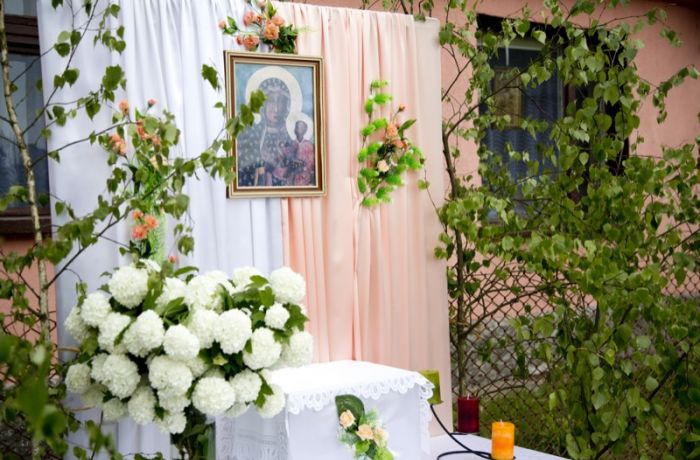
Фоторепортаж с празднования Праздника Тела и Крови Христовых в 2016 году ищите здесь.
День этот является в костёльной классификации Торжеством, то есть занимает высшее место среди католических церковных праздников. В этот день верующие обязаны посещать мессу и воздерживаться от любой работы, которая не является крайне необходимой.
Праздник не имеет чётко установленного дня в календаре и отмечается в четверг, следующий за Днём Святой Троицы, на одиннадцатый день после Пятидесятницы (Pięcdziesiątnica, Zesłanie Ducha Świętego – Сошествие Святого Духа или, как этот день часто называют в Польше, – Zielone Świątki – Зелёные Святки).
В 2017 году праздник отмечается 15 ююня.
Праздник Boże Ciało, известный также как Corpus Christi (лат.), был установлен 11 августа 1264 года папой римским Урбаном IV, а утверждён он был в 1314 году папой Климентом V – он и дал празднику название. Праздник призван был приблизить верующих к различным аспектам присутствия Христа в Таинстве Евхаристии. Первое упоминание процессии Корпус Кристи в Польше относится к XIV веку. Прошла она в Плоцке (Płock). Задокументированное праздненство, от которого можно вести официальный отсчёт, относилось к краковской епархии. Зафиксировано оно было в 1320 году. Вскоре (в масштабах истории, разумеется), примерно к середине XV века, праздник уже был известен во всей Польше. К концу века XVI счёт участников процессий шёл уже на тысячи.
Уличные процессии
Традиция тысячных процессий неуклонно развивалась, превращаясь в массовое движение.
Вот и в наши дни, в Праздник Тела и Крови Христовых, по улицам Польши проходят яркие поющие потоки людей, объединённых возвышенностью происходящего.
В этот день после окончания мессы формируется процессия, впереди которой идёт ксёндз, ступая по устланной цветами и лепестками дороге, держа в руках накрытую балдахином Дароносицу. На улице под открытым небом сооружаются четыре алтаря, прибранные зелёными веточками берёзы и цветами. Кругом разносится запах ладана. Нарядно одетые девочки рассыпают из специальных красивых корзинок лепестки роз перед процессией, которая поочерёдно подходит алтарям. Возле каждого из них произносится молитва.
Количество алтарей, разумеется, не случайно и имеет своё значение, как и всё в этом празднике.
Они символизируют четыре стороны света, четыре элемента жизни: огонь, воду, землю и воздух – созданные по Слову Бога, и четыре Евангелия: от Марка, Матфея, Луки, и Иоанна. Процессии могут проходить как по улицам, так и вокруг храма. В этом случае они приобретают форму круга как символа идеальности мироздания. Шествия, проходящие по улицам, имеют форму квадрата, что символически является равнозначным кругу. Квадрат тоже даёт абсолютную законченность, как и круг.
В давние времена процессии ходили вокруг костёла на протяжении всей октавы, то есть 8 дней праздника Корпус Кристи. Восьмёрка в литургике тоже имеет символ законченности, бесконечности и совершенства – как квадрат или круг. Если мы присмотримся поближе, то увидим, что духовные праздники в Польше привязаны именно к октаве – восьмёрке. Ранее торжественность сопровождала всю октаву. Всё это время звонили колокола, по улицам разносилось молитвенное пение, возле четырёх алтарей проходили сценические представления с библейскими персонажами, а также читались стихи на духовные темы.
На протяжении столетий Праздник Тела и Крови Христовых оброс в Польше рядом традиций, обычаев и атрибутов. В частности, это касается украшений алтарей. Со временем – это хорошо видно в современном обличии праздника – традиция украшения четырёх алтарей перенеслась верующими на улицы города. Повсеместно украшаются дома, улицы, причём даже те, по которым процессия идти не будет. Традиционным украшением являются веточки берёз, цветы, разнообразные венки. Обычай этот укоренился и распространился так широко благодаря вере в то, что венки, цветы и ветви, освящённые у алтарей, приобретают целебные свойства.
Венки: украшение и польза
Небольшие веночки, величиной с ладонь, перетянутые красной праздничной лентой, висели после мессы в костёлах на протяжении всей октавы праздника Тела и Крови Христовых, украшая помещения храма. Считалось, что венки эти под воздействием времени (8 дней) набирают чудодейственной силы. После окончания октавы праздника любой желающий мог забрать веночки домой. Венки плели и сами верующие. Со временем венок стал неотъемлемым атрибутом праздника.
Было в этом и прагматичное зерно. Дело в том, что венки часто изготавливались из цветов и трав, которые и так обладали лечебным свойством.
До сих пор в венках используются целебные травы. Одной из основных трав в венке была полынь лечебная – божье дерево (bylica boże drzewko). Она обладала приятным запахом и могла после высушивания использоваться в качестве приправы для мясных блюд. Она же играет немаловажную роль в венках в ночь на Святого Иоанна (Noc Kupały или Noc Świętojańska). Кроме того, в венке использовались розмарин, незабудки, ромашка, маргаритки, васильки, полезнейший по своим свойствам копытень, росянка, мать-и-мачеха, ежевика, пижма, любисток и другие травы. Если посмотреть на их разнообразие и учесть, что они сплетались в венок, который в дальнейшем высушивался, то нетрудно догадаться, что человек получал запас лекарственных трав на очень и очень долгое время. Кроме этого, цветки и травы обладали и своей символикой в венке. Все они использовались в ритуальных целях ещё в дохристианские времена. К таким же древним временам относятся и верования, что в октаву Корпус Кристи активизируются духи и чародеи.
В Польше, богатой традициями земледелия, венкам придавали особое значение в вопросе защиты полей. Хозяева пашен – а это было подавляющее большинство жителей Польши – приходили на службу в храмы с четырьмя венками. Венки освещались вместе с четырьмя чтениями Евангелия, выписанными на четырёх отдельных листках, свёрнутых в трубочку. После венки закапывались в четырёх концах поля. Земледельцы верили, что эти освящённые веночки защитят посевы от града в течение года. Примерно такое же применение находили и веточки с алтарей. Их втыкали по периметру поля, чтобы обезопасить его от вредителей. Обычай отрывать веточки от украшения алтарей до сих пор является распространённой в Польше традицией.
Символ любви
Многотравные венки были и символом любви. Девушки вили парням маленькие веночки и надевали им на левую руку, что-то вроде обручального кольца. Венки покрупнее вешались над дверями в овины, хлев, хозяйский дом и над окнами. Считается, что они – оберег от града, грозы и молнии. Также их подкладывали под фундамент при закладке дома. Выезжая в поле пахать, клали венок в первую борону, «чтобы Бог благоволил урожаю». Их же клали на пол в овины, в место, где сгрузят первый собранный урожай зерна. Дымом венка окуривали скот, отправляя его впервые после зимы пастись на луга, а также посуду и места приготовления хлеба.
Почитание хлеба
С самых своих начал Праздник Тела Христова, был неразрывно связан именно с хлебом. Хлеб, по христианской традиции, заложенной самим Иисусом Христом, символизирует Тело Спасителя. В Польской культуре хлеб почитался как первейшая и важнейшая пища, ведь он является даром Бога человеку и напоминанием жертвы Христа. Это повлияло и на процесс обращения с хлебом как с продуктом.
Так нельзя было кушать хлеб с покрытой головой, брать хлеб грязными руками, с хлебом запрещалось играть, нельзя было также лепить из него фигурки. Даже малейшие крохи хлеба не выбрасывались, а сжигались в печи.
Повсеместно существовали специальные метёлки и лопаточки для собирания крошек хлеба со стола.
Каравай хлеба нельзя было класть вверх ногами, нельзя было бросать, вынув из печи, да и вообще нельзя было тыкать в хлеб ножом. Не то что кидаться хлебом, но даже случайно уронить его считалось грехом. Уронивший должен был быстро поднять и трижды поцеловать кусок. Обычай целования хлеба жив в Польше до сих пор. Он присутствует в момент приветствия молодожёнов или гостей «Хлебом-солью». Возвращается в обычай выпекание специальных хлебцев к празднику.
Лайконик
Яркие зрелищные процессии на улицах Польши в День Тела и Крови Христовых – это зрелище, которое можно описывать очень и очень долго, но лучше всё же один раз увидеть самому. Точно одно. Оказываясь в гуще событий, даже далёкие от веры люди проникаются атмосферой всеобщего духовного подъёма и светлой радости. Традиционно выделяется на фоне остальных польских городов Краков. То, что происходит там, можно сравнить с бразильским карнавалом, только с духовным началом. Насколько красочными были торжества в Кракове уже в давние годы, можно судить по указу краковского епископа, имевшему место в 1787 году. Уже тогда традиционная для Кракова процессия с Лайкоником возбудила в нём смущение своей пёстростью и перехлёстывающей нарядностью. Епископ наказал «братствам и цехам принимать участие в процессии без одежд вычурных, либо чересчур броских, или смех пробуждающих, а только чтоб были они согласны с уставом Костёла Святого и побуждали чтоб к христианским добродетелям и набожности». Под запретом оказался один из самых ярких персонажей процессии – Лайконик.
Лайконик – один из символов Кракова, связанный с наездом татаро-монгол на польские земли в 1241 и 1247 годах.
Вторым символом является гейнал (Hejnał), звучащий с башни костёла Святой Марии на центральной площади. Этот персонаж изображает татарского всадника в стилизованном восточном костюме. Он пляшет на протяжении всего своего маршрута по улицам города, размахивая знаменем Кракова. С вышеупомянутым указом прервалась история Лайконика в процессии. Но пляски «татарского» кукольного всадника так нравилась краковянам, что Лайконика попросту сдвинули по времени. С тех пор Лайконик танцует в октаву праздника Тела и Крови Христовых. Но, как мы уже сказали, лучше один раз увидеть.
Темы
Фотоматериалы

Оставайся на связи
Подписывайся на наш Telegram-канал и будь в курсе последних новостей и нововведений в Польше. Также делимся интересными и полезными материалами.
В Польше отмечают католический праздник Тела Господня и в этот день в стране выходной. Официально он называется «Праздник Тела и Крови Христовых». «Праздник Тела и Крови Христовых» отмечается на 60 день после Пасхи.
Он приходится на четверг после Торжества Святой Троицы между 21 мая и 24 июня. В Польше он начал праздноваться в 1320 году (был введен в Краковскую епархию епископом Нанкиром). В 2023 году «Праздник Тела и Крови Христовых» празднуется 8 июня. В Польше это выходной день, так как это государственный праздник. К слову, у православных нет аналога этому дню.
Corpus Christi (название на латыни) считается одним из самых важных церковных праздников и имеет исключительно красивую и торжественную обстановку. На польском он называется Boże Ciało. В этот день можно увидеть праздничные шествия около костелов и вдоль дороги (особенно в сельской местности). Во главе обычно идет священник, который несет в дароносице (называется монстранция) Тело Христово – белый круглый пресный хлеб. Также сопровождают священников девочки в белых платьях, которые рассыпают лепестки цветов. Шествие идет «на четыре стороны света»: поочередно к четырем алтарям, которые расположены за территорией костела, у каждого алтаря шествие останавливается, и священники читают отрывки из Евангелия.
Главная цель празднования Bożego Ciała — публично исповедовать веру в присутствие Иисуса Христа, почитать его и благодарить за милости, попросить прощения за грехи.
Традиции и особенности
Этот особый для поляков праздник получил свои особые традиции в разных регионах Польши, фото его празднования в городе Лович даже попало на обложку National Geographic в 1924 году. Более того, традиция праздновать этот день в Ловиче была внесена в Польский список нематериального культурного наследия человечества ЮНЕСКО. Именно по этой причине в этот город приезжает много туристов, чтобы полюбоваться традиционным шествием. Местные жители в этот день наряжаются в праздничные традиционные костюмы. Поэтому это мероприятие привлекает не только верующих, но и тех, кто хочет поближе познакомиться с культурой Польши.
Также праздник не должен обходиться без молодых берез, либо шествие должно проходить по улице, где есть эти деревья, либо (в некоторых регионах Польши) люди делают венки с ветками из молодой березы и надламывают их над священными образами или хлевом.
Учитывайте, что по ходу праздничного шествия в этот день в столице (и других крупных городах) перекрывают дороги, меняется движение общественного транспорта.

Подписывайся на инсту
Подписывайся на наш Instagram, там еще больше интересных и полезных постов о Польше.
ТЕЛА ХРИСТОВА ПРАЗДНИК
- ТЕЛА ХРИСТОВА ПРАЗДНИК
- (лат. Corpus Christi), в Римско-католической церкви, праздник, совершаемый в четверг после католического праздника Троицы в воспоминание об установлении таинства евхаристии. Обычай впервые возник в 1247 в Льежской епархии (Бельгия). В 1264 папа Урбан IV сделал этот праздник общецерковным, даровав индульгенции всем, кто принимал участие в праздничной мессе. Чинопоследование праздника Тела Христова сочинил Фома Аквинский, и текст этой службы считается одним из красивейших в римском Бревиарии. Пышные процессии — характерная особенность этого праздника. В Йорке, Уэйкфилде, Ковентри и других английских городах в 14, 15 и 16 вв. эти процессии оказали значительное влияние на развитие драмы и драматического искусства. Сцены из Библии представлялись городскими ремесленниками: каждому цеху принадлежала одна повозка, на которой разыгрывалась определенная сцена (мистерия). Передвижные подмостки останавливались в определенных местах, где участники мистерии и разыгрывали свою сцену, так что зрители, оставаясь на месте, могли видеть представление из последовательности небольших пьес, которые составляли единый драматический цикл.
Энциклопедия Кольера. — Открытое общество.
2000.
Смотреть что такое «ТЕЛА ХРИСТОВА ПРАЗДНИК» в других словарях:
-
Тела Христова — – праздник у католиков в первый четверг после Троицына дня в честь Тела Христова, установленный папой Урбаном IV в 1264 году … Полный православный богословский энциклопедический словарь
-
праздник — является одной из важных форм общественной жизни; он связан с кризисными, переломными моментами в жизни природы, общества и человека. Функции средневекового П.а многочисленны и разнообразны. П. в средние века был всегда поводом для… … Словарь средневековой культуры
-
Праздник Успения Пресвятой Богородицы — Во саду Богоматерь дремлет, Словно спит Она и не спит, В тонком сне Она пенью внемлет, Божий вестник пред Ней стоит. М. Кузмин. Успение 28 августа Русская Православная Церковь празднует Успение Пресвятой Богородицы. Праздник Успения один из самых … Энциклопедия ньюсмейкеров
-
Праздник Святой Троицы — День Святой Троицы Эль Греко. «Сошествие Святого Духа на апостолов». Тип христианский, в ряде стран государственный иначе Пятидесятница, Троицын день, Троица … Википедия
-
Праздник Сердца Христова — Икона Иисуса и Его Пресвятого Сердца Праздник Сердца Иисуса, в Католической церкви праздник, посвящённый почитанию Святейшего Сердца Иисуса Христа. Отмечается в пятницу, на восьмой день после праздника Тела и Крови Христовых и на двенадцатый… … Википедия
-
Торжество Пресвятого Тела и Крови Христовых — Католическая церковь отмечает Праздник Тела и Крови Христовых, в 2010 г. этот день приходится на 3 июня. Праздник, именуемый по латыни Corpus Christi , празднуют во всем католическом мире, где он является выходным. Торжество Пресвятого Тела и… … Энциклопедия ньюсмейкеров
-
Пасха — праздник Светлого Христова Воскресения — Праздник Светлого Христова Воскресения, Пасха, главный праздник православных христиан. Он празднуется в первое воскресенье после первого весеннего полнолуния между 4 апреля (22 марта по старому стилю) и 8 мая (25 апреля по старому стилю), после… … Энциклопедия ньюсмейкеров
-
Православный праздник Рождество Христово — 7 января православные верующие празднуют Рождество Христово. Это один из самых важных праздников всех христианских церквей, это день начала новой эры. В этот день во всех храмах православной Церкви служится ночная праздничная Литургия. Праздником … Энциклопедия ньюсмейкеров
-
ГРОБА ГОСПОДНЯ (ВОСКРЕСЕНИЯ ХРИСТОВА) ХРАМ В ИЕРУСАЛИМЕ — Главный храм христ. мира, где заключены 2 святыни и свидетельства Воскресения Христова Голгофа и Гроб Господень, а также др. cв. места, связанные с искупительной жертвой Иисуса Христа, его Крестными страданиями и Воскресением. Храм Гроба Господня … Православная энциклопедия
-
Сервантес Сааведра Мигель де — (Cervantes Saavedra) (1547 1616), испанский писатель. Пасторальный роман «Галатея» (1585), патриотическая трагедия «Нумансия» (около 1588), «Назидательные новеллы» (1613), «Новые восемь комедий и интермедий» (1615), любовно приключенческий роман… … Энциклопедический словарь
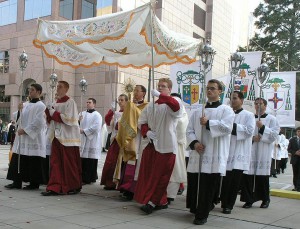
Рим: праздник Божьего Тела с Бенедиктом XVI
В Италии четверг, в который отмечается этот праздник, давно стал рабочим днем. После II Ватиканского Собора Конференция епископов Италии перенесла его на ближайшее воскресенье, однако Папа Иоанн Павел II в первый же год своего понтификата вернул обычай совершать процессию с Дарами в Риме именно в четверг. Теперь празднование начинается в Риме вечером, по окончании рабочего дня.
В 19.00 Бенедикт XVI возглавил праздничную Мессу в базилике Св. Иоанна на Латеранском холме. В своей проповеди понтифик обратил внимание на связь, существующую между священством и Евхаристией. Именно Евхаристия проясняет смысл Христова священства. Во время Тайной Вечери Иисус Христос принес в жертву хлеб и вино, выражая этим жестом Свою личность и Свою миссию. Он умер на кресте, погруженный в молитву, смысл которой – полное единение Его воли с волей Отца. Эта воля есть воля любви. Именно благодаря послушанию Иисуса воле Отца в Нем исполнился Божий замысел любви.
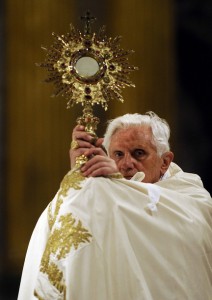
Праздничная Месса в четверг совершается на площади перед Латеранской базиликой Св. Иоанна. После Мессы в этот день обычно проходит Евхаристическая процессия во главе с Папой. Ее маршрут традиционно пролегает по Виа Мерулана, от базилики Св. Иоанна до базилики Санта Мария Маджоре. Впереди на специальном автомобиле, оборудованном платформой, следует Святая Монстранция, за ней на «папамобиле» – Святой Отец. В Риме во время процессии в праздник Божия Тела не воздвигаются четыре алтаря, как это принято во многих странах. Вместо этого читаются специальные Евхаристические размышления, в промежутке между которыми верные поют гимны.
В этом году, однако, непогода внесла свои коррективы в программу праздника. Из-за сильного дождя Месса прошла не перед храмом Св. Иоанна, а внутри него. Процессия была и вовсе отменена, а вместо нее состоялась Адорация в том же храме.
Испания: празднование с особым размахом

Тем не менее, в 1991 г. выходной день в четверг был официально отменен, а праздник Божьего Тела перенесен на воскресенье. Однако это решение вызвало многочисленные протесты по всей Испании. В результате решением местных властей во многих областях страны выходной день в четверг и праздничные церемонии в этот день были возвращены. В некоторых городах, как, например, в Толедо, проходит две процессии – одна в четверг, а другая в воскресенье.
Евхаристическая процессия в Толедо отличается особой красочностью, наверное потому, что Толедо – это резиденция примаса Испании. А в этом году она была особенно пышной еще и по той причине, что следовала сразу за окончанием (30 мая) X Евхаристического Конгресса Испании. Жители города начинают готовиться к празднику загодя: за несколько дней до начала торжеств украшаются улицы, по которым пройдет процессия, и храмы. Над мостовой растягивается полупрозрачная ткань, таким образом образуется нечто вроде балдахина, под которым будут следовать Святые Дары. На 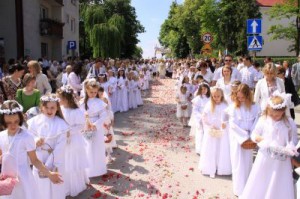
Накануне праздника церковные братства вручают награды самым заслуженным своим членам и принимают в свои ряды новых кандидатов. На улицах появляются группы музыкантов, чья задача – призвать горожан принять участие в празднованиях. Около 23.00 по маршруту процессии проходит специальная группа, с помощью мерного прута определяющая размеры монстранции и ширину улиц и удостоверяющая отсутствие преград на всём пути.
Во время процессии используется трехметровая монстранция, изготовленная в XVI веке известным мастером Энрике де Арсе по заказу кардинала Сиснероса и хранящаяся в сокровищнице Кафедрального собора Толедо. На ее изготовление пошло 180 кг серебра, 20 кг золота и множество драгоценных камней. Монстранцию везут на специальной платформе.
Процессия совершается по правилам 300-летней давности. Перед монстранцией шествуют церковные братства (чем старше их возраст, тем ближе к монстранции). Во главе процессии движется распятие XVI века, за ним – в красных одеждах так называемые «инфансонес», т.е. дворяне близлежащей области Ильескас, далее – в голубых одеждах так называемые «Мозарабские кавалеры», т.е. лица, доказавшие свое христианское происхождение со времен арабского господства или занятые изучением Мозарабской эпохи в Толедо. Следующая группа – Рыцари Святого Гроба в белых одеждах. Они составляют почетную гвардию примаса Испании. Далее шествуют в характерных зеленых плащах с белыми крестами Рыцари Божия Тела, к числу которых принадлежат известные лица из Латинской Америки и сотрудники Института испанской культуры. Непосредственно перед монстранцией идут дети, принявшие в этот день свое Первое Причастие.
Сразу за монстранцией идет примас Испании, архиепископ Браулио Родригес, за ним – представители региональных и городских властей, депутаты городского совета, главы местного самоуправления.
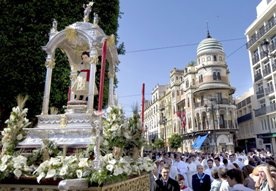
Некоторое замешательство в подготовку праздника в этом году внесла министр обороны в социалистическом правительстве страны Карме Чакон, потребовавшая, чтобы курсанты и преподаватели Толедского военного училища не участвовали в процессии и не воздавали традиционных почестей Святым Дарам. Однако всеобщее возмущение заставило ее отменить свое распоряжение.
Празднование в честь Пресвятых Тела и Крови Христа не заканчивается в Испании вместе с Евхаристической процессией. Городские власти обычно организуют в этот день концерты и фестивали, которые продолжаются до поздней ночи. В Гранаде эти фестивали длятся всю неделю.
Бельгия: возобновлена Евхаристическая процессия на «родине» праздника Божия Тела в Льеже
В Бельгии в этом году после сорокалетнего перерыва возобновлена Евхаристическая процессия в городе Льеже, в котором некогда впервые стали отмечать праздник Божия Тела. Это произошло в 1246 г. по инициативе Льежского архидиакона Жака Леодийского, а позднее Папа Урбан IV под влиянием мистических видений св. Юлиании из Корнильона распространил празднование на всю Церковь. В Льеже торжество Божия Тела всегда отмечалось с большой пышностью. Маршрут процессии пролегал вдоль реки Маас, а Святые Дары передвигались на специально украшенной барже. Однако с 1970 г. Евхаристические процессии здесь не проводились.
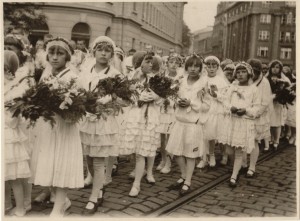
Иерусалим: церемония в храме Воскресения
В литургическом календаре Святой Земли торжество Пресвятых Тела и Крови Христа перенесено на ближайшее воскресенье. Однако, в виду особого статуса Иерусалима и храма Гроба Господня, в этом городе празднование всё же прошло в четверг. Согласно решению Конференции католических ординариев Святой Земли, оно стало одним из последних пунктов повестки дня близящегося к своему завершению Года Священника.
В базилике Воскресения (католический придел храма Гроба Господня) собрались многочисленные священники и миряне, среди них – немало паломников и туристов. Мессу на алтаре Гроба Господня возглавил недавно получивший хиротонию викарный епископ Иерусалимского латинского патриарха Вильям Шомали. Ему сослужили 5 епископов и свыше 70-ти священников. Молящиеся благодарили Бога за ныне заканчивающийся Год Священника. Епископ Шомали в своей проповеди подчеркнул, что праздник Тела Господня сокровенным образом указывает на дар священства, в основании которого лежит Пасхальная тайна. Слова Христа: «Сие творите в Мое воспоминание», прямо относятся к Жертве, имевшей место прямо здесь, на Голгофе. Отличительным свойством священника, — сказал епископ Шомали, — должно быть послушание Богу и Церкви.
По окончании Мессы торжественная Евхаристическая процессия троекратно обошла Гроб Господень и прошла у подножия Голгофы. Почитание Святых Даров имело место у Гроба Господня, у алтаря Марии Магдалины и в часовне Пресвятой Евхаристии.
Польша: десятки тысяч верных приняли участие в Евхаристических процессиях
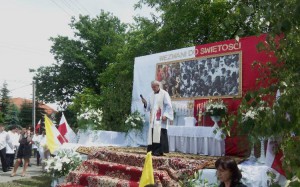
Председатель Конференции епископата Польши архиепископ Юзеф Михалик возглавил процессию в Пшемышле на востоке страны. В своем слове он призвал паству голосовать на предстоящих в июне президентских выборах за кандидатов, отстаивающих католические моральные ценности.
В Кракове кардинал Станислав Дзивиш отметил, что в мире, раздираемом войнами и конфликтами, Иисус Христос призывает нас к единству. Только в этом случае наше свидетельство о Нем будет убедительным. «Он, Сын Божий, пришел в мир и пожертвовал Своей жизнью, чтобы собрать в одно стадо рассеянных детей Божьих. Дело восстановления единства, созидания общины – это задача каждого очередного поколения», — сказал кардинал.
Нынешнее празднование проходит в преддверии знаменательного и очень важного для Польши события. В воскресенье 6 июня в Варшаве на площади Пилсудского состоится церемония беатификации священника Ежи Попелушко – капеллана независимого профсоюза «Солидарность» в годы тоталитарной диктатуры, погибшего от рук коммунистических спецслужб осенью 1984 г.
Архиепископ Варшавский Казимеж Ныч по окончании процессии призвал поляков к единству во имя верности заветам о. Попелушко. «Этот призыв обращен ко всем без исключения, — сказал архиепископ. – Ищите путей польского единства, которое будет стоять на службе всем людям, всем семьям, всем слоям общества. Соревнуйтесь друг с другом в выработке программ обновления нашего отечества не только в ходе предвыборной кампании, но постоянно, руководствуясь заботой о национальных интересах».
Со своей стороны, архиепископ Люблинский Юзеф Жичиньский заявил, что в воскресенье 6 июня, сразу же после провозглашения о. Попелушки блаженным, издаст декрет, которым отдаст под его покровительство один из приходов своей епархии.
В России торжество Пресвятых Тела и Крови Христа по решению Конференции католических епископов РФ будет отмечаться в воскресенье 6 июня.
Перевод: Сибирская католическая газета

